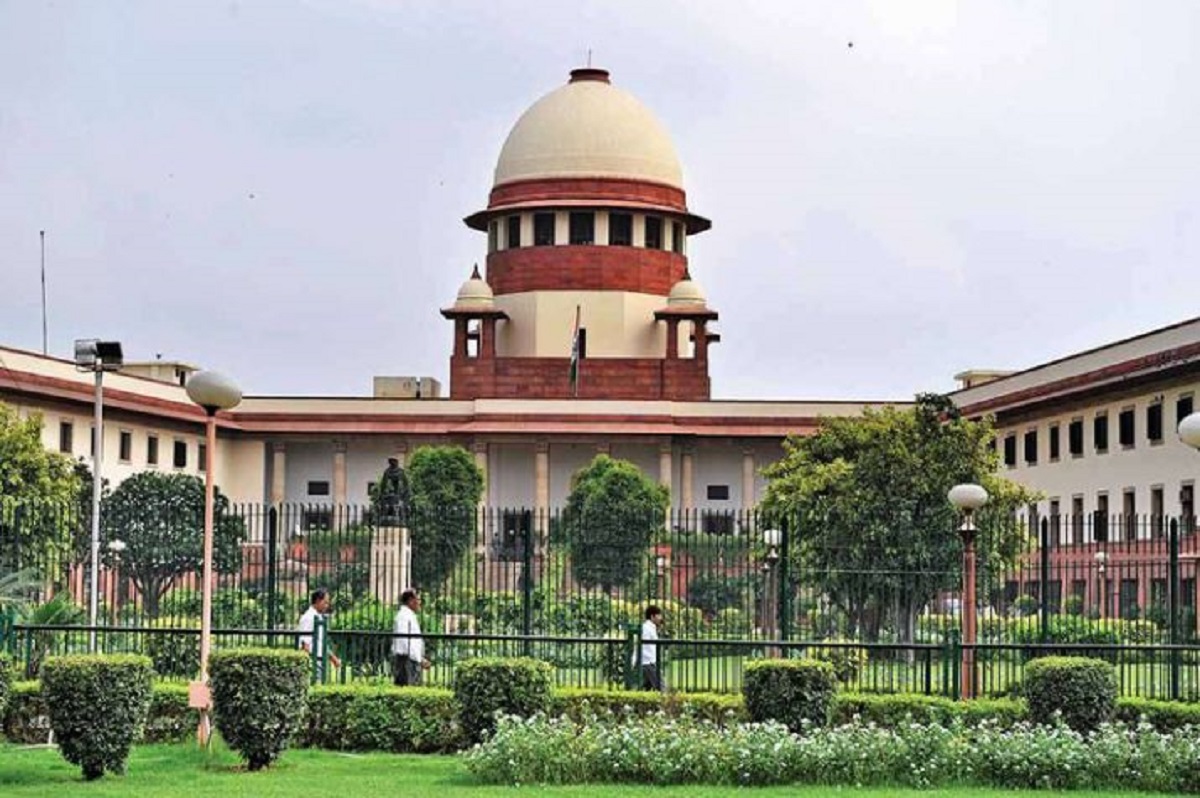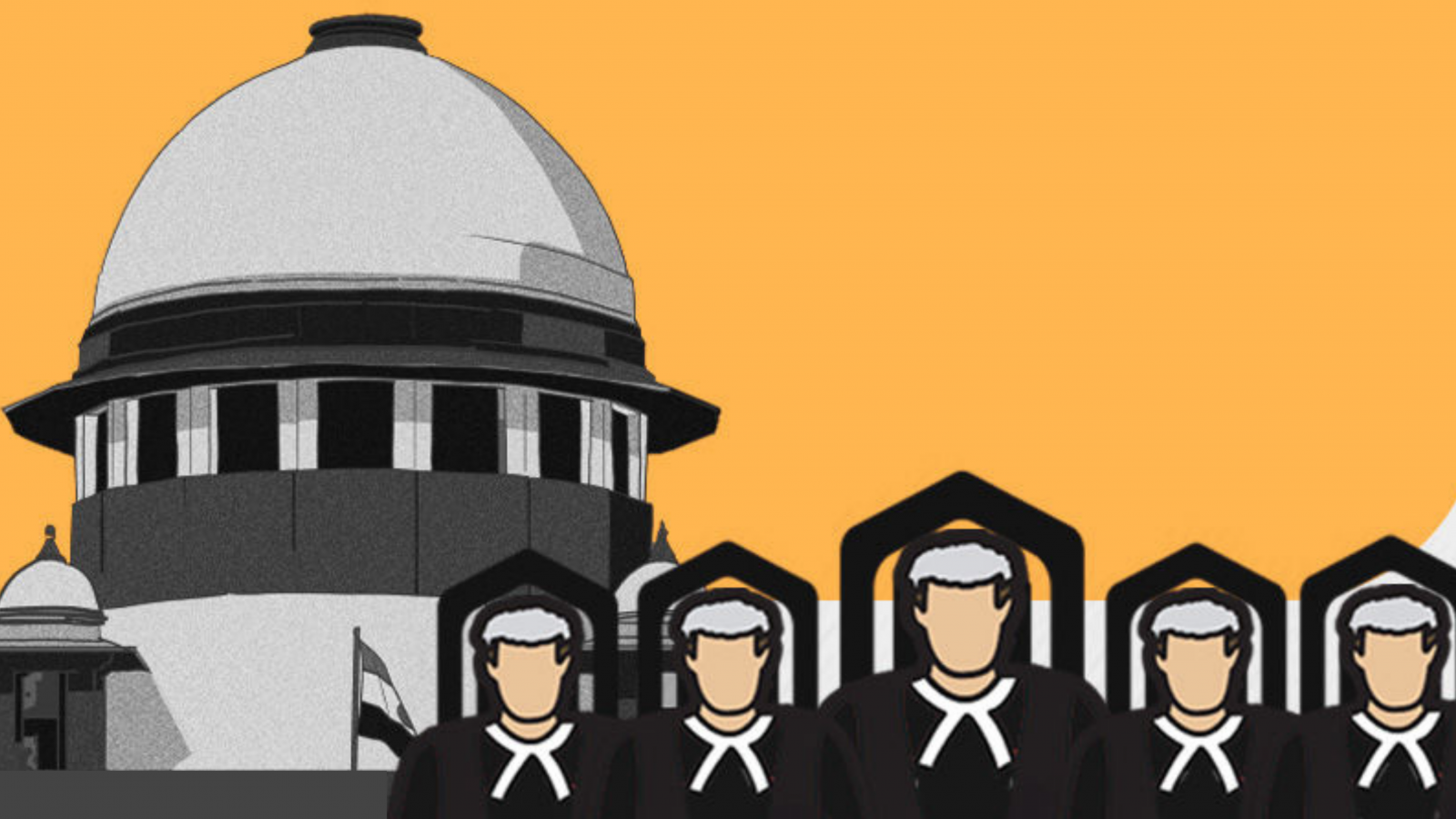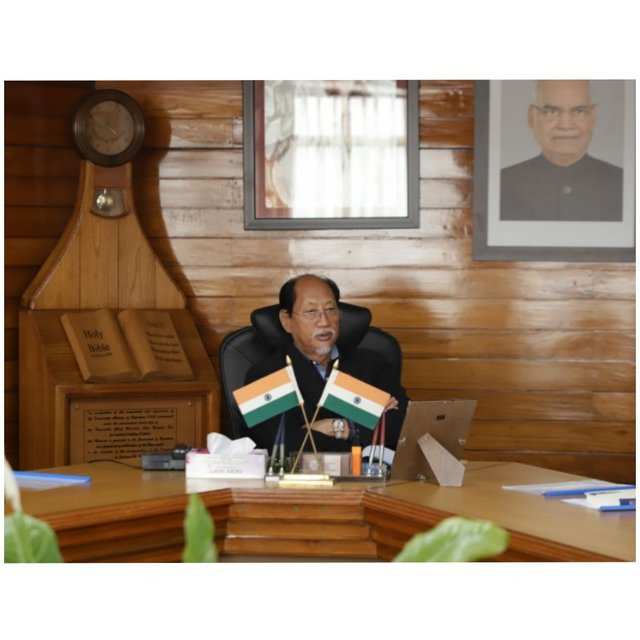Supreme Court of India
- Adopted from the Government of India Act of 1935
- Supreme Court is the highest court of appeal. The constitution deals with jurisdiction, independence, powers, procedures, and organization. Parliament can also regulate them. It can increase the number of judges. Parliament can’t curtail the jurisdiction but expand it only
- Supreme Court has the power to punish for its contempt.
- The appointment of judges is done by the president. For the chief justice, the president consults as many judges of the Supreme Court and high court as he may deem necessary. For the other judges he has to consult the chief justice of India and as many other judges of the S.C and H..C as he may deem necessary.
- The conduct of the judges in the performance of their duties can’t be discussed in parliament except when a motion for their impeachment is being considered.
Composition of Supreme Court of India
- 34 Judges i.e. 01 CJI & 33 Other Judges
Qualification
- He should be a citizen of India
- He should fulfill at least one criterion from below:
- He should be a judge of H.C in succession for 5 years
- He should be an advocate of H.C in succession for 10 years
- He should be a distinguished jurist in the opinion of the president.
Tenure
- Occupies office till he attains the age of 65 yrs.
- Can resign anytime in writing to the president.
- Can be removed by the president on the recommendation of parliament.
Salaries and allowances of the judges:
- They are determined by the parliament
- The salaries and emoluments of the judges cannot be varied to their disadvantage after their appointment except during the financial emergency
Appointment
- Judges appointed by the president
- CJI is appointed by the president after consultation with such judges of the Supreme Court and high courts as he deems necessary.
- Other judges appointed by the president after consulting with CJI & such judges of the Supreme Court and high courts
- Consultation with the chief justice is obligatory in the case of
appointment of a judge other than the Chief justice.
- The Collegium System is a system under which appointments/elevation of judges/lawyers to the Supreme Court and transfers of judges of High Courts and Apex Court are decided by a forum of the Chief Justice of India and the four senior-most judges of the Supreme Court.’ There is no mention of the Collegium either in the original Constitution of India or in successive amendments.
- How collegium system was born?
- First judges case (1982): The court held that consultation does not mean concurrence and it only implies the exchange of views.
- Second judges case (1993): The court reversed its earlier ruling and changed the meaning of the word consultation to concurrence. Hence, it ruled that the advice tendered by the CJI is binding on the President in matters of appointment of SC judges. But any such advice would be tendered after CJI consults with two of his most senior judges. It was also decided in the case that President should appoint the senior-most judge in the SC as the CJI.
- Third judges case (1998): The consultation process to be employed should be based on the plurality of judges. He should consult a collegium of four senior-most judges before making a recommendation to the President and even if two judges give an adverse opinion, he should not send the recommendation to the President.
Removal
- A motion support removal must be supported by 100 LS / 50 RS members. The presiding officer may or may not admit it. If admitted an inquiry committee of the Chief justice of India or a Supreme Court judge; the Chief justice of the high court and distinguished jurist checks if a judge is guilty; if the committee finds the judge guilty then parliament can pass a motion by a special majority in both houses.
- An address supported by this motion must be presented to the president on the same day.
- Then by presidential order, the judge can be removed.
Acting CJI or Adhoc S.C. Judges
- President can appoint an S.C. judge as acting chief justice if the Chief justice is absent or can’t perform his duties or the office is vacant.
- The chief justice with the previous consent of the president may appoint ad-hoc judges to the Supreme Court by nominating high court judges who are duly qualified.
- The consultation of the chief justice of the high court is also needed.
- Also, retired judges of H.C. or S.C. can be appointed if their consent is there. But he won’t be considered an S.C. judge.
- Retired judges of S.C. are banned from pleading or acting in any court before any authority in India.
- The C.J.I. can with the approval of the president designate other seats of S.C. too.
The seat of the Supreme Court of India:
- Article 130 of the Constitution declares Delhi as the seat of the Supreme Court. It also authorizes the CJI to appoint other places or places as seats of the Supreme Court.
- He can take decisions in this regard only with the approval of the President. This provision is only optional and not compulsory.
- This means that no court can give any direction either to the President or to the Chief Justice to appoint any other place as the seat of the Supreme Court.
The procedure of the Court:
- The Supreme Court can, with the approval of the president, make rules for regulating generally the practice and procedure of the Court.
- The Constitutional cases or references made by the President under Article 143 are decided by a Bench consisting of at least five judges.
- All other cases are decided by single judges
and division benches. - The judgments are delivered by the open
- All judgments are by majority vote but if differing, then judges can give dissenting judgments or opinions.
Independence
- It is a federal court, the highest court of appeal, the guarantor of the fundamental rights of the citizens, and the guardian of the Constitution.
Provisions to safeguard and ensure the independent and impartial functioning of the Supreme Court
- Mode of Appointment
- Security of Tenure
- Fixed Service Conditions
- Expenses Charged on Consolidated Fund
- The conduct of Judges cannot be Discussed
- Ban on Practice after Retirement
- Power to Punish for its Contempt
- Freedom to Appoint its Staff
- Its Jurisdiction cannot be Curtailed
- Separation from Executive
Jurisdiction of the Supreme Court of India:
Original Jurisdiction:
- As a Federal court, the Supreme Court decides disputes between different units of the Indian Federation. More elaborately, any dispute between:
- the Centre and one or more states; or
- the Centre and any state or states on one side and one or more states on the other; or
- between two or more states.
- In the above federal disputes, the Supreme Court has exclusive original jurisdiction.
- Further, this jurisdiction of the Supreme Court does not extend to the following:
- A dispute arising out of any pre-Constitution treaty, agreement, covenant,
- engagement, sansad, or other similar instruments.
- A dispute arising out of any treaty, agreement, etc., which provides explicitly that the said jurisdiction does not extend to such a dispute.
- Interstate water disputes.
- Matters referred to the Finance Commission.
- Adjustment of certain expenses and pensions between the Centre and the states.
- Ordinary dispute of Commercial nature between the Centre and the states.
- Recovery of damages by a state against the Centre.
Writ Jurisdiction:
- The Supreme Court is empowered to issue writs, including habeas corpus, mandamus, prohibition, quo-warranto, and certiorari for the enforcement of the fundamental rights of an aggrieved citizen.
- In this regard, the Supreme Court has original jurisdiction in the sense that an aggrieved citizen can go directly to the Supreme Court, not necessarily by way of appeal.
- However, the writ jurisdiction of the Supreme Court is not exclusive. The High Courts are also empowered to issue writs for the enforcement of Fundamental Rights.
Appellate Jurisdiction:
- The Supreme Court is primarily a court of appeal and hears appeals against the judgments of the lower courts. It enjoys a wide appellate jurisdiction which can be classified under four heads:
- Appeals in constitutional matters
- Appeals in civil matters
- Appeals in criminal matters
- Appeals by special leave.
Appeal by special Leave:
There may be some instances where the Supreme Court may interfere with the judgment of the High Court or tribunals where the question of justice is involved. Such residuary power is given to the Supreme Court under Article 136.
Advisory Jurisdiction:
- The Constitution under Article 143 authorizes the President to seek the opinion of the Supreme Court in the two categories of matters:
- On any question of law or fact of public importance which has arisen or is likely to occur.
- On any dispute arising from any pre-constitution treaty, agreement, covenant, engagement, sand, or other similar instruments.
A Court of Record:
- As a Court of Record, the Supreme Court has two powers:
- The judgments, proceedings, and acts of the Supreme Court are recorded for perpetual memory and testimony. These records are admitted to be of evidentiary value and cannot be questioned when produced before any court.
- They are recognized as legal precedents and legal references.
- It has the power to punish contempt of court, either with simple imprisonment for a term of up to six months or with a fine of up to 2,000 or with both.
Power of Judicial Review:
- Judicial review is the power of the Supreme Court to examine the constitutionality of legislative enactments and executive orders of both the Central and state governments.
- On examination, if they are found to be violative of the Constitution (ultra-vires), they can be declared illegal, unconstitutional, and invalid (null and void) by the Supreme Court. Consequently, they cannot be enforced by the Government.
Miscellaneous Jurisdiction:
- There are provisions for reference to this Court under Art. 317(1) of the Constitution, s. 257 of the Income-tax Act, 1961, Jurisdiction. s. 7(2) of the Monopolies and Restrictive Trade Practices Act, 1969, s. 130A of the Customs Act, 1962 and s. 35H of the Central Excise and Salt Act, 1944.
- Appeals also lie to Supreme Court under the Representation of the People Act, 1951; Monopolies and Restrictive Trade Practices Act, 1969; Advocates Act, 1961; Contempt of Courts Act, 1971; Customs Act, 1962; Central Excise and Salt Act, 1944; Terrorist Affected Areas (Special Courts) Act, 1984·; Terrorist and Disruptive Activities (Prevention) Act, 1985; Trial of Offences relating to Transactions in Securities Act, 1992 and Consumer Protection ACL, 1986.
- Election Petitions under Part III of the Presidential and Vice- Presidential Elections Act, 1952 are also filed directly in the Supreme Court.
- Art. 323A-323B. These two new Articles' intent was to remove the Supreme Court's jurisdiction under Art. 32 over orders and decisions of Administrative Tribunals. These Articles could, however, be implemented only by legislation which Mrs. Gandhi’s first Government had no time to undertake.
- But subsequently, the position turned out to be otherwise as the Supreme Court declared the Articles 323 A, 01. 2(d) and 323-B, CI. 3(d) and also the “exclusion of jurisdiction” clauses in all the legislations enacted In pursuance of these Articles, unconstitutional to the extent they excluded the jurisdiction of the High Courts and the Supreme Court under Articles 226 – 227 and 32
- Art. 368(4)-(5). These two clauses were inserted in Art. 368 with a view to preventing the Supreme Court from invalidating any Constitution Amendment Act on the theory of ‘basic features of Constitution’ or anything of that nature.
- Curiously, however, these Clauses have been emasculated by the Supreme Court Itself, striking them down on the ground that they are violative of two ‘basic features of the Constitution-(a) the limited nature of the amending power under Art 368, and (b) judicial review, -in the Minerva Mills case.
Supreme Court Advocates:
- Senior Advocates
- not entitled to appear without an Advocate-on-Record in the Supreme Court or without a junior in any other court or tribunal in India
- not entitled to accept instructions to draw pleadings or affidavits, advise on evidence or do any drafting work of an analogous kind in any court or tribunal in India.
- Advocates-on-Record
- entitled to file any matter or document before the SC
Supreme Court- Recent Issues:
Master of Roster:
- It refers to the Chief Justice's authority to form Benches to hear matters.
- In the Supreme Court, a debate has erupted regarding the Chief Justice's absolute jurisdiction over judicial administration.
- The administrative side is headed by the Chief Justice of India or the Chief Justice of any high court. This also applies to the distribution of cases before a judge.
- As a result, unless the Chief Justice of India assigns it to him, no Judge can take up the case on his own.
Important Articles of Supreme Court
- Article 124-Establishment and Constitution of Supreme Court
- Article 129-Supreme Court to be a court of record
- Article 130 The Supreme Court shall sit in Delhi or in such other place or places
- Article 131-Original jurisdiction of the Supreme Court
- Article 132: Appellate jurisdiction of Supreme Court in appeals from the High Court in certain cases
- Article 133: Appellate jurisdiction of Supreme Court in appeals from High Courts regarding civil matters
- Article 134: Appellate jurisdiction of Supreme Court regarding criminal matters
- Article 134A: Certificate for appeal to the Supreme Court
- Article 135: Jurisdiction and powers of the Federal Court under existing law to be exercisable by the Supreme Court
- Article 136: Special leave to appeal by the Supreme Court
- Article 137: Review of judgments or orders by the Supreme Court
- Article 138: Enlargement of the jurisdiction of the Supreme Court
- Article 139: Conferment on the Supreme Court of powers to issue certain writs
- Article 140: Ancillary powers of Supreme Court
- Article 141: Law declared by Supreme Court to be binding on all courts
- Article 142: Enforcement of decrees and orders of Supreme Court and orders as to discovery, etc.
- Article 143: Power of President to consult Supreme Court
- Article 144: Civil and judicial authorities to act in aid of the Supreme Court
- Article 145: Rules of Court, etc.
Conclusion:
The Supreme Court of India has built a reputation for itself and is well-known in the field of legal and judicial jurisprudence. The Court is an homage to the Constitution's framers. In keeping with the people's customary tolerance, the Court has never been inattentive or harmful to minorities and their rights, but has always been alive and protecting them. The judiciary has performed admirably, and the people of India can rightfully assert that the judiciary's independence is adequate proof of the country's democratic achievement.
THANKS FOR READING.......







No comments:
Post a Comment